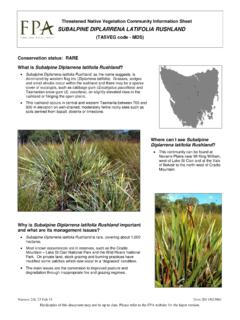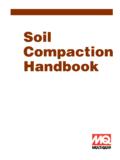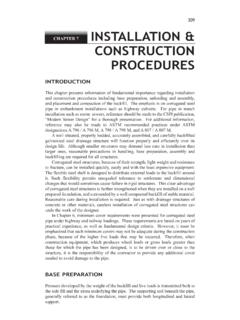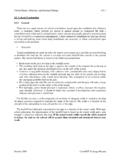Transcription of D:alpha1 soils facts sheetss - The Forest Practices …
1 Site descriptionOccurrence: Mainly on east coast below 500 m where rainfallis in the 500-800 mm range; on hilly and strongly rolling sites(probably having younger soils than much of the dolerite terrain)Parent Material: In-situ strongly weathered Jurassic doleritewith thin dolerite colluvium cover and aeolian additions at thesurfaceLandform: Strongly rolling land dissected by hilly and steep-sidedgulliesDrainage Class: Well drained and moderately well drained(where mottles occur below 60 cm depth)Vegetation: Dry sclerophyll Forest with Eucalyptus globulus,E. obliqua, Acacia sp. and introduced soil PropertiesProfile Features: Loamy over clayey profile without a bleached A2 horizon(contrasts with Eastfield soil ) Upper B horizon is clayey with strong structure C horizon is massive or has weak structure (in situ weatheredrock)Chemical and physical features Medium total C, total N and total P in topsoil (0-30 cm) Very low SO4-S throughout profile High Ca, Mg and K levels Moderate aggregate stability Permeability moderate, limited by C horizon (note mottles indescribed profile)Similar soils soil , Forest soils of Tasmania (Eastfield soil ) prominent pale A2 horizon present soil , Forest soils of Tasmania - under dry Forest at higher altitude Brown soils on dolerite (Spanswick et al.)
2 2000) - red-weathered in subsoilsTasmanian Forest soil fact sheet no. 1 Driscoll soil loamy over clayey soil in dolerite and minoraeolianquartz under dry forestSoil Degradation PotentialFACTORRATING OF DEGRADATION POTENTIALE rodibility:ModerateCompaction and puddling:ModerateMixing:ModerateNutrient depletion:Moderate (N and P)Landslides:ModerateFlooding:Negligible Site ProductivityLow productivity, limited primarily by low moisture availability and low N, P and S availabilitySoil ManagementSoils on hilly and steep slopes are prone to erosion following clearing and/or cultivation. Excessivedisturbance and burning will reduce Forest Logging and RegenerationLOGGING AND CLEARING: soils with few stones are unsuitable for wet-weather logging; bouldery and stony soils are suitable for wet-weather logging provided soils are not saturated and runoff is FOR REGENERATION:Scarification of the soil surface or burning is required for good germination.
3 Hot burns not recommendedbecause of low N status. Success of regeneration depends on moisture CONSIDERATIONS:Low water availability limits long-term productivity. Long-term management as a low wood-productionforest following appropriate partial logging operations is likely to be the most viable for PlantationsMarginally suitable to unsuitable for plantations, limited by low productivity and droughtinessCLEARING: Care must be taken to retain the surface soilsCULTIVATION: Ripping to break up firm subsoils will be beneficialFERTILISER: N and P and S fertiliser is required at planting and secondary fertilisation is necessarythroughout the rotationProfileAuthors: MDL and PDMDate: : West side of Buckland Road, Driscolls Hills, km north of BucklandMap reference: Sheet 5428 (Buckland) 563 866 Landform: Midslope of hilly gully side 100 m longVegetation.
4 Eucalyptus globulus, Acacia dealbata, saggs, native cherry, grassesParent material: Dolerite colluvium on in situ-dolerite, with aeolian quartz sand in A horizonDrainage: Well drainedSlope: 18 Aspect: NortheastAltitude: 150 mPhotographs: PDM 10-00-4 (site); 9-00-13a (profile)Australian soil Classification: Eutrophic Brown ChromosolLaboratory AnalysesA10-21 cmDark greyish brown (10YR4/2) (moist) silty loam; 15% subrounded gravels 10-40 cm diameter; weak strength; weak 1-2 mm subangular blocky structure;abundant fine roots; NaF 0 cmBrown ( ) (moist) medium clay; 15% subrounded gravels 10-40 cmdiameter; weak strength; strong 5-15 mm blocky structure; prominent darkbrown ( ) clay skins on block faces; many fine roots; NaF 0 cmBrown ( ) (moist) coarse sandy loam; 10% subrounded gravels 10 cmdiameter; firm strength; weak 3-8 mm blocky structure breaking to 2 mmblocky; prominent dark brown ( ) clay skins on block faces; commonfine roots; NaF 0 cmStrong brown ( ) (moist) coarse sandy loam; 30% light olive brown( ) mottles 20 mm diameter, below 80 cm depth; firm strength; massive;10% subrounded gravels 10 cm diameter; few roots; NaF 0/5; in situ (cm)pH(H2O)TotalC(%)TotalN(%)C/NColwellP (mg/kg)TotalP(mg/kg)P retn.
5 (%)SO4-S(mg/kg)Water-stableaggreg.(%) (cm)Exch. Ca(cmol(+)/kg)Exch. Mg(cmol(+)/kg)Exch. K(cmol(+)/kg)Exch. Na(cmol(+)/kg)CEC(cmol(+)/kg)BS(%) methods were those of Blakemore et al. (1987), Laffan et al. (1996) and Rayment and Higginson(1992), with variation of methods for C, N and SO4-S (details available from P. D. McIntosh, ForestPractices Board). July 2001 ReferencesBlakemore, L. C.; Searle, P. L. and Daly, B. K. 1987. Methods of chemical analysis of soils . New Zealand soil BureauScientific Report , M. D.; Grant, J. and Hill, R. 1996. A method for assessing the erodibility of Tasmanian Forest soils . AustralianJournal of soil and Water Conservation 9: 16 , G. E. and Higginson, F. R. 1992. Australian Laboratory Handbook of soil and Water Chemical Press, Melbourne, , S.
6 ; Kidd, D.; Loveday, J. and Dimmock, G. M. 2000. Buckland soil Report. A revised edition of DivisionalReport 13/57 Buckland. DPIWE, Tasmania, 44 pages plus Gunns Ltd and Forestry Tasmania, for funding soil :McIntosh, ; Laffan, ; Wong, L.; Miller, M. and Holz, G. 2001. Driscoll soil . Tasmanian Forest soil fact sheet Forest Practices Board, Hobart; Gunns Ltd, Launceston and Forestry Tasmania, Hobart. 4 p.










